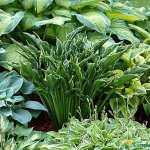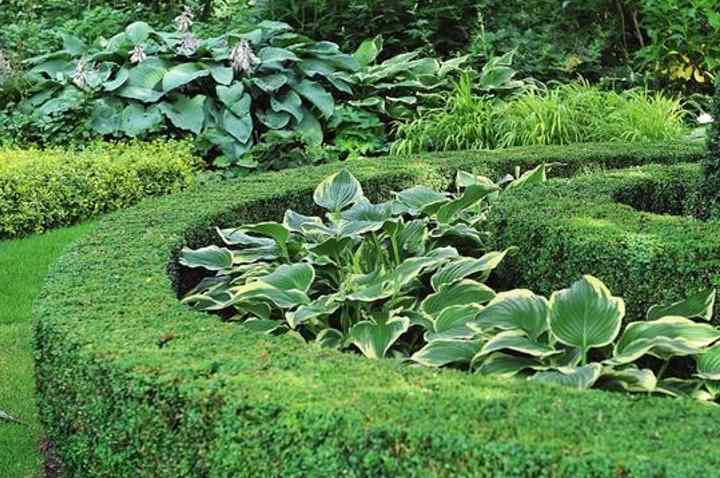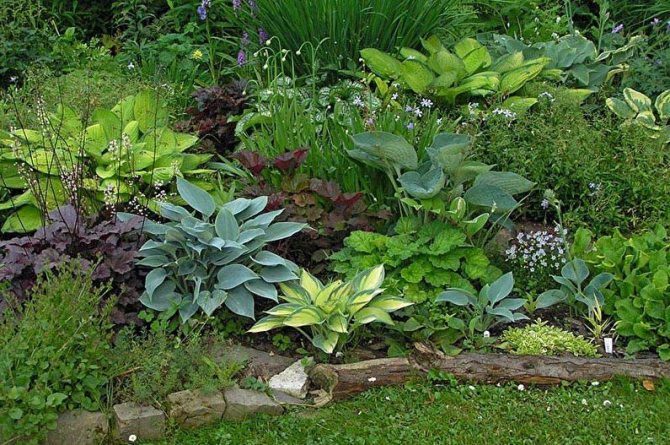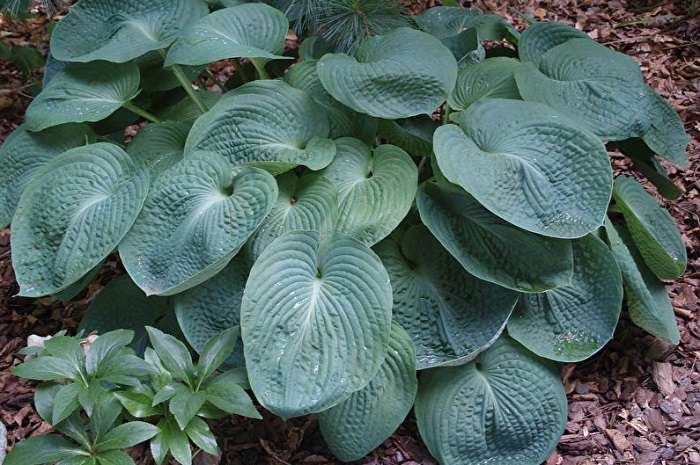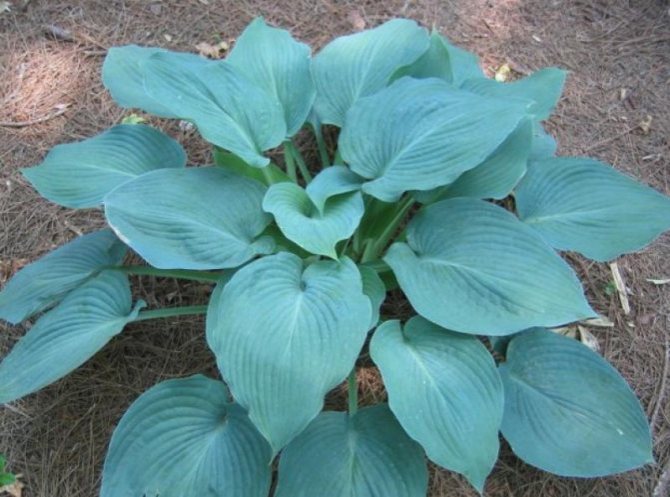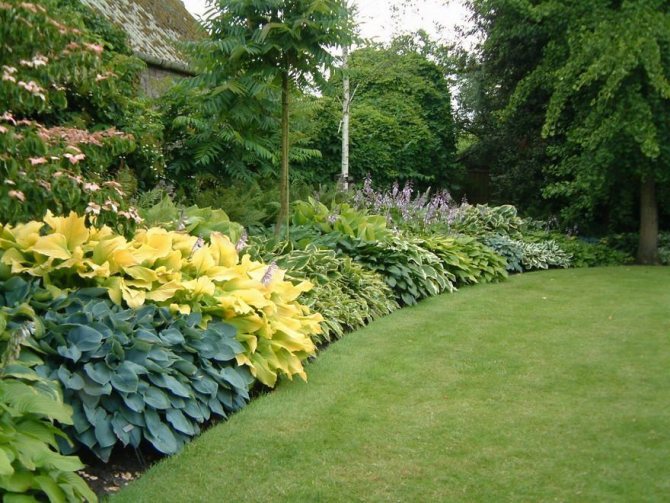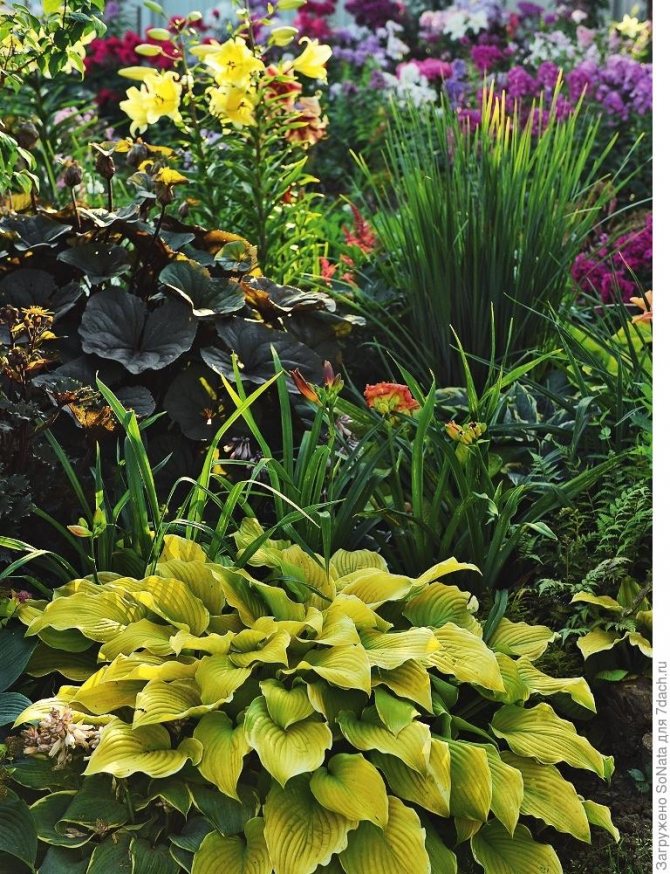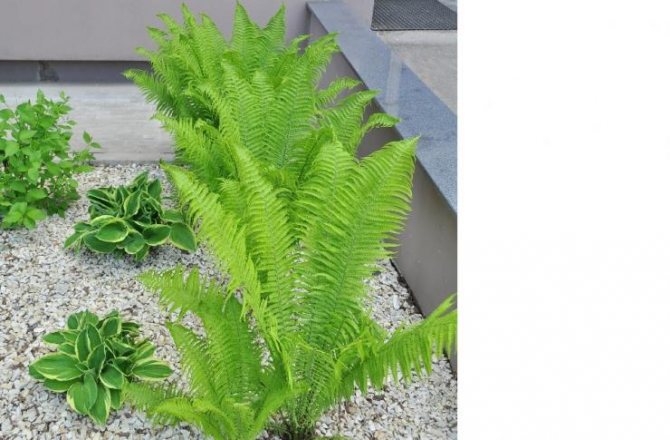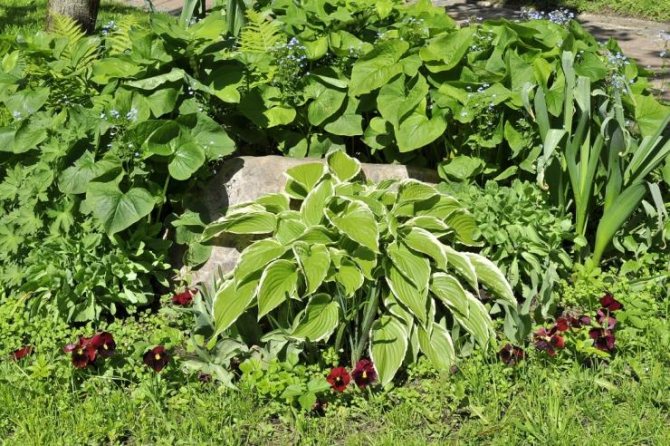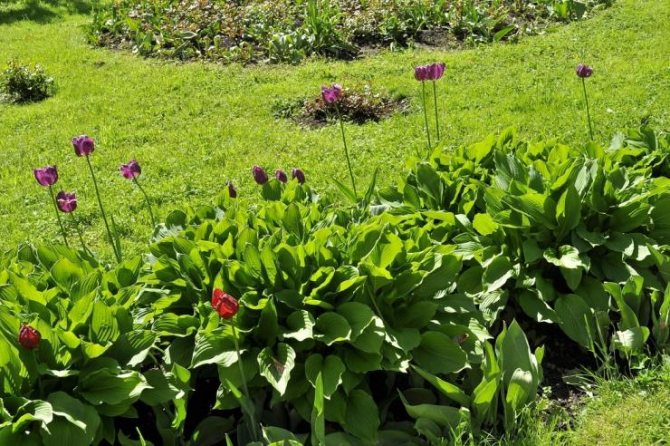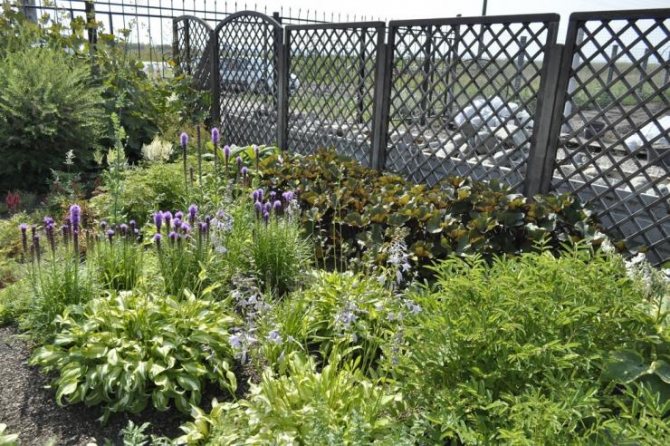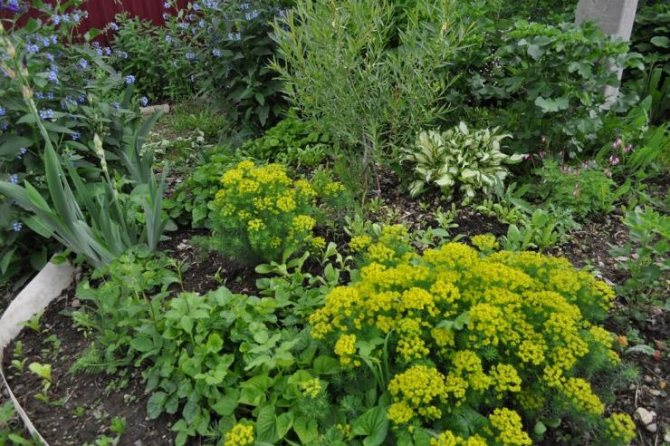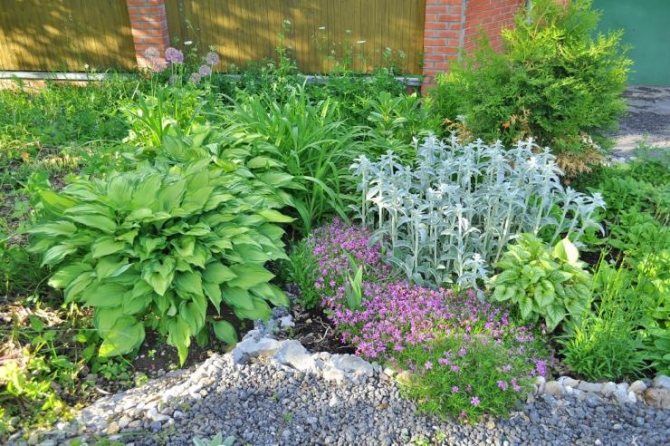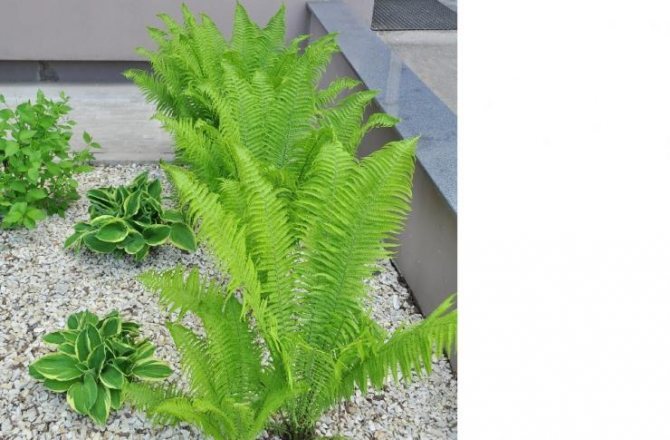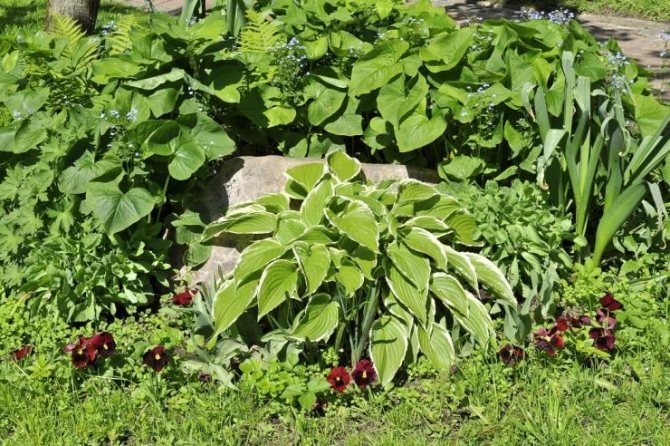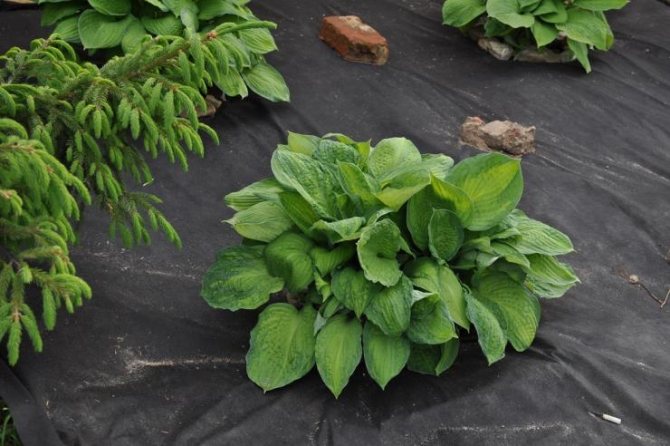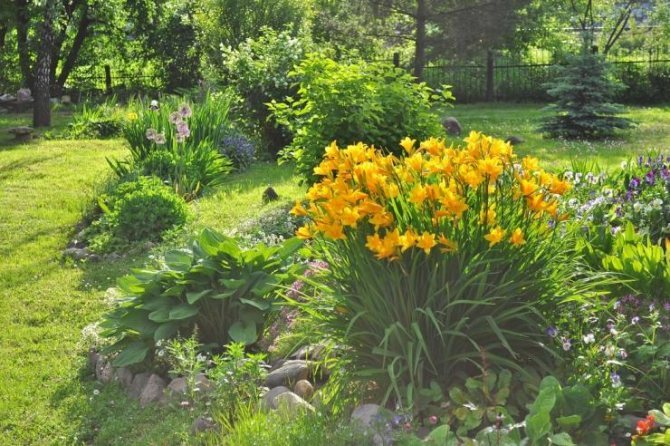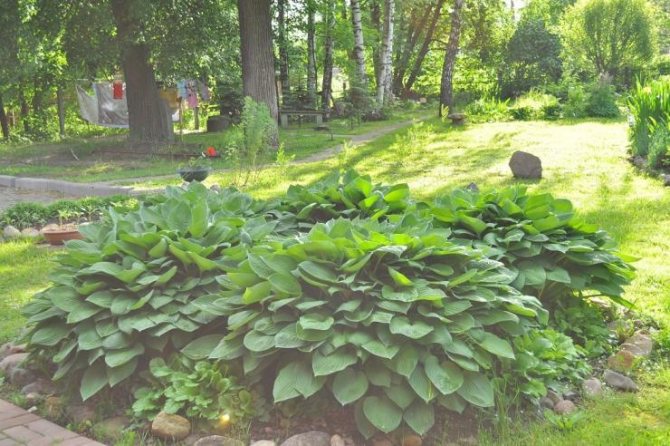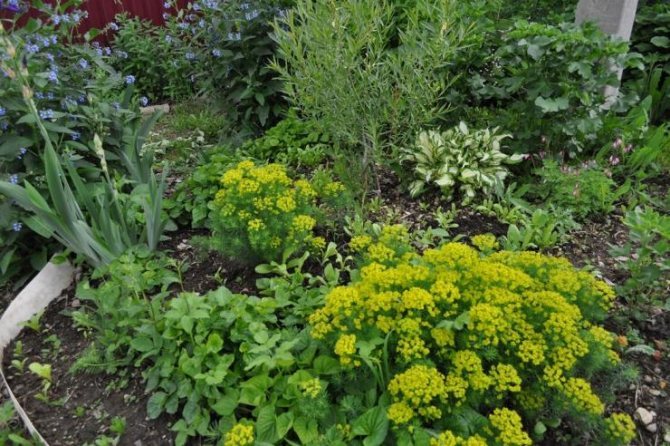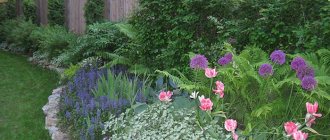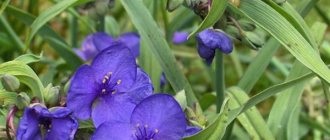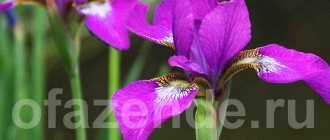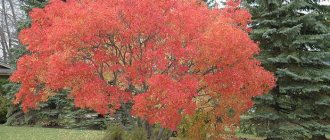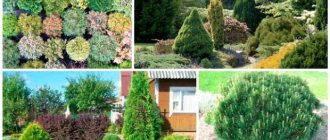Nature has created innumerable different plants. Moreover, in the natural environment there is no dissonance in the combination of various neighboring cultures. With a good imagination, you can learn a lot from the wild to create a paradise on the site. For example, hosts in the garden, landscape tricks when growing it, are of great interest in decorating a flower plot. The use of hosts in garden landscaping when decorating flower beds has many options. The abundance of varieties and types of this culture (about 50 species and more than 700 varieties) will help create completely charming compositions.
Basic rules of landscape design
If you do not go into the complexity of the design, you can note for yourself some quite understandable rules. They consist of:
- Unity of style. This means that both the buildings on the site and the flower beds should be in the same style. If you wanted to grow a garden in some kind of national entourage, then the entire landscape will have to be brought under this type, that is, to disguise buildings and fences, to choose consonant plants.
- Simplicity of design. It's not about boringness, but about the dosage of the details of the future garden. A small area, loaded with unnecessary design, causes anxiety and a sense of lack of taste in the creator of the composition.
- Domination and submission. One prominent plant is chosen as the basis for the future flower garden, and all the rest are selected for it. The goal is to achieve a single composition, where each plant is designed to highlight the beauty of the main element.
Therefore, even before creating a garden, it is worth choosing the right plants, decorative details suitable for them (figurines, borders, tiles for paths, lanterns, fountains).
Important! Any component of the composition can be chosen as the main element, including decorative elements.
Geometry in creating a flower garden
The use of geometric shapes in the planning of a flower garden complements the design solutions. Depending on the task at hand, the size and shape of the site, its location, the following are used:
- Triangle rule. In a simple way, this means that first tall plants are planted, for example, trees, then lower bushes and then flowers. Shades of foliage from high to low also vary from deep green to light green, light green and yellow. Moreover, each group is planted in a triangular shape.
- The rule of the circle. The circle helps to distribute the color and light spectrum on the site. It can be divided into 2 or more parts and plants with related shades of flowers (leaves) can be planted in each of them. Only the rule of 3 colors, 3 sizes and 3 shapes should be observed.
- Square rule. It is based on the cardinal points and implies the planting of plants according to the size and characteristics of the content.
How beautiful it is to plant hosts in their summer cottage, in the garden
To use a plant in the landscape, before breeding, you need to find a permanent place for it and decide what to plant next to the hosta. Transplanting the culture is undesirable. It is recommended to renew the planting after 6-10 years.
For your information! Hosta is capable of forming a dense green cover at the landing site in 2 years.
The place should be shady, calm with slightly acidic wet soil. For lush growth, you should immediately pinch the appearing pedicel.The beauty of the hosta is in the leaves, and the flowers are rather inconspicuous, so you can do without flowering.
Handsome host in the country
When planting, it is important to keep in mind that every year the plant will become more luxuriant, which means that you will need good space around.
Choosing a site for planting a plant
You can grow hosts in the garden even in the center of the site, even in the background. Only it is worth considering what plants the hosts are combined with. Based on the shade of the leaves, neighboring flowers are selected. For example, blue will look stylish with white, yellow with red, and other shades with green.
Important! If you have doubts about the selection of a place, then you can try to plant them in different areas and observe where they grow better. This place can be chosen as permanent for the next season.
How to plant hosts beautifully
The most unpretentious of the plants that are planted in a personal plot or in a garden is considered a hosta. It grows even in the most shaded areas. Many of its varieties feel great both in sunlit areas and in the corners of the garden with diffused but bright light.

Variety of types of hosts
Florists recommend that you determine the best place to place your hosta by planting it in different parts of the garden. Next year, it will become clear in which of the selected areas the plant feels better. This can be determined by the color of the foliage. Then you can transplant the grown bush to the chosen place. A perennial is unpretentious in care and perceives a change in habitat painlessly. If necessary, the host can be grown in a container for the purpose of landscaping balconies and terraces.
Advice. It is better to grow a perennial plant by dividing the rhizome. Experienced florists find this method more convenient than growing hostas from seed.
The plantings of this herbaceous plant look beautiful in the design of the carpet. Its large leaves do not allow weeds to grow in the garden. In this case, the carpet is considered not only decorative, but also useful.
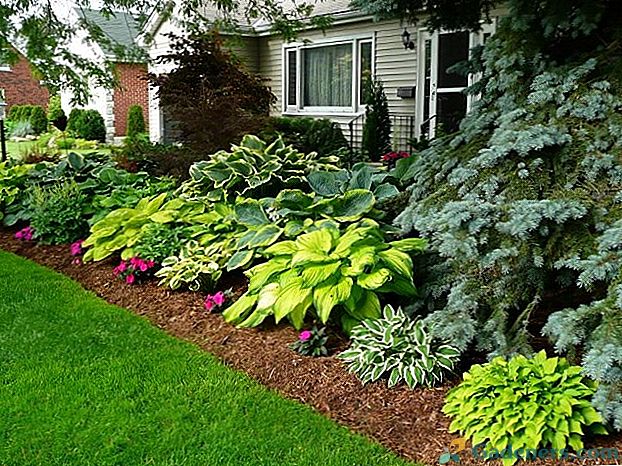

Neighborhood with conifers and juniper
Hosta on an alpine slide
The basic varieties of the crop are quite large. They are of little use for alpine slides. But through the efforts of breeders, dwarf plant species have been bred. In addition, some of their properties have been improved. For example, resistance to sunburn, decorative flowers.
New host hybrids
About 20 such hybrids were obtained. The most spectacular of them are:
- Venus is a plant with small, shiny, heart-shaped leaves;
- Shining Tot has beautiful pale lilac flowers;
- Variegata - a native of Japan, has beige leaves with a light green and green border;
- longissima Maekawa is distinguished by narrow emerald leaves with a ruffled border;
- Ground Master is the owner of narrow and long leaves, which are framed by a yellow stripe, and a very dense root system. It can be planted to strengthen the soil on the shore of the reservoir;
- Kabitan A distinctive feature of the species is lanceolate, folded leaves with a light green center and a dense green stripe along the edge.
Hosta green plantain Venus
Also the hosts Lemon Lime, Vanilla Cream and Geisha look amazing. They are all yellow.
Dwarf hosts
Of the dwarf blue, the following are in great demand:
If it is impossible to acquire dwarf forms, it is quite possible to get by with basic varieties. On an alpine slide in the sun, their leaves will be smaller than in the shade.
Important! Hybrid varieties grow more slowly than base varieties.
Nevertheless, in the rock garden, hosts recommend placing them in the shade of stones or other plants. In any case, they should not be planted at the top, it is worth choosing a place at the foot of the hill. It is even better if the flower garden approaches the reservoir.
Benches and hosts
Not far from the host alley, put a small bench to relax and enjoy the landscape.To do this, study the design of garden benches in more detail and choose the appropriate option..
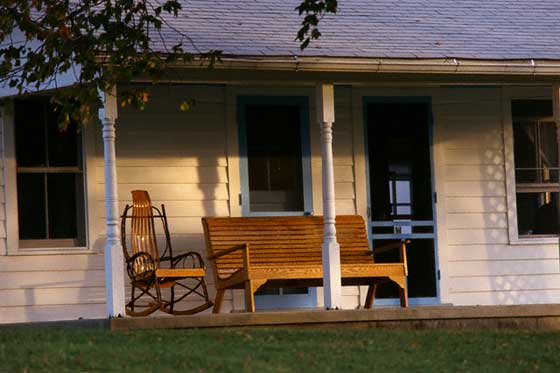

Benches at home
Types of garden benches:
Waiting bench
Such a bench should be located near the entrance to the house. The analogue is called the Russian zavalinka. A bench is an indispensable element for receiving visitors or people you don't want to invite into your home.
Summer bench
Usually such a bench is located on the north side of the house or near large trees so that it remains in the shade throughout the day. It is on it that we will hide from the burning sun rays.
Autumn-spring bench
This bench is the complete opposite of a summer bench. It should be placed in a place where the sun stays the longest in spring and autumn.
Some more interesting solutions
Gardener bench
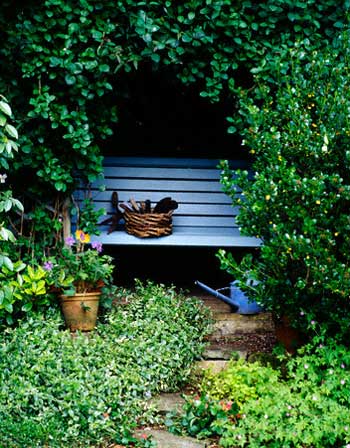

Gardener bench
Having worked well in the beds, every summer resident secretly dreams of being on a bench in order to straighten his strained back and visually evaluate his work. In this case, it is best to install a bench with a backrest closer to the garden.
Bench by the water
You can look at the water forever, especially if you have a bench and can sit down. On the shore of a garden pond or fountain, there must be a bench of this type.
Dining bench
Most often, such a bench is installed near a large summer table, where the whole family gathers for lunch in nature or in the summer kitchen.
Why hosta changes color of leaves
The change in leaf color in many host species is genetically inherent. Under all conditions, they will change color during the growing season. Shades can vary from white to blue. But their change can also occur from climatic conditions or violation of the rules of content. Variable species can be divided into:
- Viridescent is when any initial spring foliage color changes to a deep green towards the end of the season;
- lutescent - these leaves change in color from the original light yellow (yellow, variegated) to dark yellow;
- albescent - host leaves from spring yellow, light green and green become white by autumn;
- bluescent - the change in shades goes from blue to green, and the transformation occurs already in the middle of the season.
There are hosts with unchanging color, which retain their original color of leaves all summer.
Features of growing hosts (video)
Another classification is based on the coloration of the hosta leaves. Three groups are distinguished here:
- Albescent, that is, leaves with shades of white. It is noteworthy that initially they have a color of green and yellow tones, but during the season they can almost completely turn white.
- Viridescent - these are hosts, in which the leaves gradually turn green (they often acquire thick, marsh green tones).
- Lutescent - yellowing plants.
According to different color combinations of petioles and leaves the following host groups are distinguished:
- Cultivars with petioles and stems have rich red-burgundy hues, which creates an additional contrast to the dark green leaves.
- Chameleon varieties, which, even in 1 season, can greatly change their color.
- 3-color varieties are usually a combination of green, yellow and blue tones. They were recently bred by breeders and look especially original.
- Chimeras are hosts that, due to their originality, do not belong to any of the classes.
The allocation of a host to one or another group is very conditional, since the plant not only differs in a wide variety of shades of leaves and flowers, but also often changes them during the season. This quality also gives the host its own unique charm.


Hosta is a plant that does not like direct sunlight.
Flower garden with hosts
Having used hosts once in a garden design, you can admire lush beautiful bushes for many years.They will decorate the flower beds even when other flowers have not blossomed. Moreover, the care for them is minimal.
Flowerbed with hosts and perennial flowers
Traditionally, hosts are planted with perennials of the type:
Closer to the reservoir, the following are added to the flower bed:
Distribution of plants according to growth
Dwarf hosta varieties are planted around evergreen coniferous bushes, and the tall variety looks beautiful alone against the background of a tall tree, near water bodies, the last row of mixborders.
Important! In a rocky garden (rockery), it is customary to combine dwarf conifers with yellow-leaved hosts.
Medium-sized hosts look good on the front row of curbs.
Half-meter species are in harmony with gladioli, lilies, delphiniums and irises of suitable growth.
Ornamental use of culture
If you decide to decorate your site with hosts, you will have the opportunity to translate any idea into reality. In order not to make a mistake with the choice, take into account the recommendations of landscape designers. The plant can become part of the composition or be located separately. You can experiment with the shape, relief and texture of the leaves.
Disembarkation of hosts separately is not practiced very often. As a rule, designers combine shapes according to height, play with the shape of the leaves and patterns. But it is worth considering that caring for them will not be easy, because each variety has its own requirements for the conditions of detention, and they bloom at different times
Monoclumba framed by boulder stones look beautiful. The composition turns out to be gorgeous if you place it near a reservoir. The host can be included in the landscape composition, provided that:
- Nearby crops have lost their foliage at the bottom.
- Plants in the flowerbed have withered or lost their decorative effect.
- The flower can act as a bright backdrop for crops that are pale in color.
Tall varieties (60-90 cm) are used as the main decoration in the design of a flower garden. They create a composition of low varieties of hosts and other plants. Dwarf varieties (height about 20 cm) are considered excellent decorative elements for stone flower beds, front tiers of flower beds. Varieties of medium height can be combined with white or purple flowers.
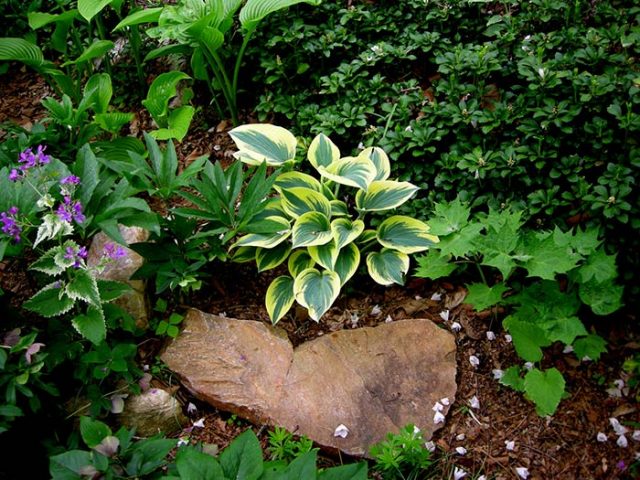

What is permissible to plant in the vicinity of the host
For example, the hosta is shade-loving, which means that it will be better to plant nearby plants that also love the shade. Here is some of them:
Roses and conifers in landscape design
The last 2 crops will look great with tall host varieties, but undersized varieties are best combined with forget-me-nots, lungwort or cuff.
Note! The host feels comfortable in the shade of a thuja or a garden cypress.
You can also create compositions exclusively from the host. Various types and varieties due to the variety of color of the leaves will help to create an original design. In this case, you will not need to plant something else next to the host.
Geraniums, ferns, mountain goats, peonies, geychera, all types of conifers are suitable for a culture as neighbors.
Hosta and roses
Being the queen of flowers, the rose does not really need neighbors. In addition, she loves open, sunny areas. But some crops are quite capable of emphasizing beauty, contributing to the preservation of moisture in the soil and preventing the attack of harmful insects. Hosta is one such plant. True, they should not be planted in close proximity to rose bushes. They are, after all, different in terms of conditions of detention. The host can pull moisture towards itself. As a companion plant, the hosta can be planted no closer than 30-35 cm from the rosebush. It is best to surround the planting of roses with one type of culture.
Successful compositions
To create a beautiful composition, you need to decide what the host is combined with. First of all, this applies to low species.
To fantasize is possible and necessary


The combination of several types of funkii in one flower bed looks great. In this case, you can play on options for the color and shape of the leaf plates. Of course, the light requirements of all plants should be similar.
Landscape tricks
Over time, some rules have been developed for growing hosts. This can be summarized as follows:
- in the vicinity of a rose, the host should be planted in a flower bed on the north side;
- incompatibility in terms of cultivation can be eliminated by planting hosts in pots. Thus, a small garden with the participation of hosts can be mixed in different ways;
- from spring frosts, plants should be mulched with a thick layer of compost and nitrogen fertilizers should be applied.
Empirically, it turned out that the host in landscape design complements the flower arrangement if:
- neighbors are rich in foliage more in the upper part;
- other components of the flower bed have faded, wilted, and lost their foliage.
Ornamental stone path decorated with hosta bushes
The culture also acts as a refreshing backdrop for nondescript plants and is used as the main decoration when creating a flower bed. Starting from tall species, a further design of the flower garden is created with lower representatives of the same culture or other suitable plants. The lowest varieties (dwarfs) are planted in the foreground of flower plantings (rockeries, rock gardens, flower beds).
Landscaping tricks and rules for composing compositions with hosts
It is possible to compose a composition from a host even under the most minimal conditions. The variety of host varieties creates rich food for the gardener's imagination.
Also read: Incarvillea or garden gloxinia: planting and growing, care recommendations
Flowerbeds of different host species
It is possible to make flower beds not only from the same plant varieties, but also from different ones, you can apply the effect of a height difference. In all these cases, the design effects are as follows:
- you can compose a composition of hosts of different varieties, since they are so different from each other that it will seem to the naked eye that the flowerbed is made of completely different plants;
- you can make islands of different shapes from hosts of the same type and height - such compositions create the effect of a natural carpet that covers the bare ground;
- another option is to use varieties with very different stem heights, due to which the compositions will somewhat resemble the multi-storey hanging gardens of Babylon.


It is possible to compose a composition of hosts of different varieties, since they are so different from each other
Hosts surrounded by astilbe and geyher
Another option is associated with a harmonious combination of host and other shade-loving plants. Some of the most popular options are associated with the use of astilbe and geyher. Both of these plants also love shade, so they the neighborhood with the host is quite favorable
- Geicher and host - this is one of the most common tandems. The fact is that the light-colored heuchera flowers perfectly complement the dark green leaves of the hosta. At the same time, heuchera forms compositions well in alternation with the host - it grows up to 45-50 cm in height, therefore it is perfectly combined with both tall hosts (planted in the foreground) and undersized ones (in this case, it itself serves as a green background).
- Astilba with the host often planted along artificial reservoirs. The fact is that the plant forms lush flowers of bright colors (from milky to lilac). This allows you to successfully combine it with a multicolored hosta. Another good reason for their combination is that the astilbe is directed upwards, and the hosta creates rounded bushes on the ground. With the help of this pair, they create wonderful living borders of the garden, borders along the paths. Also sit together in rockeries (in different combinations).
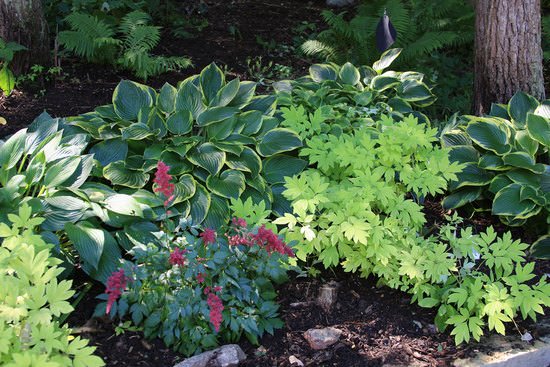

Heuchera and Hosta are one of the most common tandems
Planting plants in rock gardens and rockeries
Hosta is a real find for its use in rock gardens and rockeries. Design effects are achieved through the following features:
- Rock gardens always involve the use of multi-tiered structures based on beautiful large stones of light shades. Also, rock gardens are distinguished by the fact that their background is almost always an alpine meadow - a flat lawn of undersized greenery of delicate shades. The host fits perfectly into all these conditions. It contrasts well in alpine meadows, light stones. The host organizes the space well and visually enlarges the rock garden if you plant several plants of different heights, while highlighting the smallest ones for 1 plan.
- In the host's rockeries can not only make a beautiful combination to other neighbors, but also act as a kind of center of attraction itself. Planting large hosts at the corners and bends of rockeries perfectly organize its internal space and beautifully separate it from other parts of the garden. Low-growing hosts in rockeries form its background, and large ones can become a kind of tree around which plants with small leaves and flowers can be planted to emphasize their elegance.


In rockeries, the host can not only create a beautiful combination for other neighbors, but also act as a kind of center of attraction itself.
Subtleties when growing
How beautiful to plant hosts in a flower bed? To do this, you can apply the following techniques:
- Medium-sized hosta varieties should be combined with lilac or white flowers.
- Varieties with green and blue leaves will show the best qualities only in the shade, and yellow and light green ones need a lace shade for optimal decorativeness.
The delightful beauty of the hosta bush will be its own on any flower garden. Unpretentious cultivation makes it even more desirable for gardeners. And the ability of a culture to grow in the most unpopular areas of the garden makes them even more attractive. Only they must be protected from strong drafts! A calm, damp area in the shade - and the plant will look spectacular.
Adding an article to a new collection
The main advantage of the host is that they grow well in almost any conditions. But what is the right way to combine them with other plants?
Hosts are such hassle-free plants that it is a pleasure to grow them. They are not only unpretentious to growing conditions, but also get along well with many ornamental crops. Although certain rules are still worth following: when planting hosts, it is important to choose a place for them, protected from direct sunlight and strong winds. In addition, hosts will grow best in slightly acidic, moderately moist soil.
To determine the best place for a host on the site, you can plant these plants in different parts of the garden. After a year, it will become clear where they feel best. This can be determined by the color of the foliage, which can change depending on the growing conditions: fade or change the shade.
FEATURES OF CARE OF THE HOST
Hosta is one of the most unpretentious decorative perennial crops. In one place, it will grow well for at least 30 years.
One of the most important agricultural practices for this plant is watering. The host is very hygrophilous, therefore, in the first two years after planting, it must be watered at least twice a week. In the heat, watering can become daily.
With a lack of moisture, the leaves will lose their elasticity and decorativeness, and the plant will begin to ache. Darkening of the tips of the leaves indicates that it lacks moisture.
Hosts, especially those that grow in partial shade, are watered either early in the morning or in the evening so that the sun's rays reflecting off the water droplets do not cause burns to the plants.
Hostas grow very slowly, and the color characteristic of each variety appears, as a rule, in the third year. And if the plants do not have enough food, then by the fifth year they will not acquire their varietal sizes and colors.
Hosts are fed at least 5 times a summer.The first time, as soon as the snow melts, the bushes are watered with a solution of urea (20 g per 10 liters of water for each plant), the second and third feeding - with a solution of slurry, is carried out in May and June,
The fourth top dressing - potassium-phosphorus fertilizers - is given to plants in August after the end of flowering.
The last time they are fed in September - some kind of ready-made mineral complex for autumn fertilization of ornamental crops.
To prevent the bush from "spreading", the faded arrows are immediately cut off at the base.
Hosta has high frost resistance, but in the first 2 years, young plants are covered with spruce branches. In subsequent years, they are limited to mulching the entire flower bed with fallen leaves with a layer of 15 cm.
Dried host leaves are not removed for the winter, as they serve as additional shelter for the roots. They are carefully pruned in the spring after new shoots hatch.


Hosta in landscape design
Depending on the host variety, the leaves of plants can be shiny or dull, smooth or textured, as well as narrow, heart-shaped or rounded. How can hosts organically fit into the design of the garden, if in nature there are about 50 species and more than 700 varieties of these plants? There are several simple rules that should be followed when choosing a host for a particular place on the site.
1. For single landing high (60 cm or more) types of host are suitable. You should not plant other plants around them, because large hosts are quite self-sufficient.
2... In curbs and mixborders it is best to grow varieties up to 30 cm high. They can be placed in the foreground where they look good and do not obstruct taller plants.
3. Hosts up to 20 cm are great for growing in rockeries - rocky gardens, where they become the backdrop for flowering crops. Thus, it is better to plant hosts not in the foreground, but in the middle of the composition or in the last row.
4. Near the pond Hosts with a height of 30-45 cm look advantageous. Several such specimens growing nearby feel good in the company of other moisture-loving plants. You can also plant the hostu near the water as an independent plant if the pond is very small.
Decoration for a shady area
Hosts in the distant past have two wild ancestors. One species grew in partial shade, on the edges of forests. The second was comfortable near reservoirs, often in sunny areas. Depending on the received genetic "inheritance", modern plants can have a variety of qualities. Today there are about six hundred species and varieties.


The variety of species and its use
The color of the leaf plates can be completely different. Coloring from green and bluish to yellow and variegated can tell a novice summer resident where it is better to plant a plant:
- rich greens feel great where others do not survive - in the shade of large trees;
- lighter and more variegated develop well in openwork penumbra.
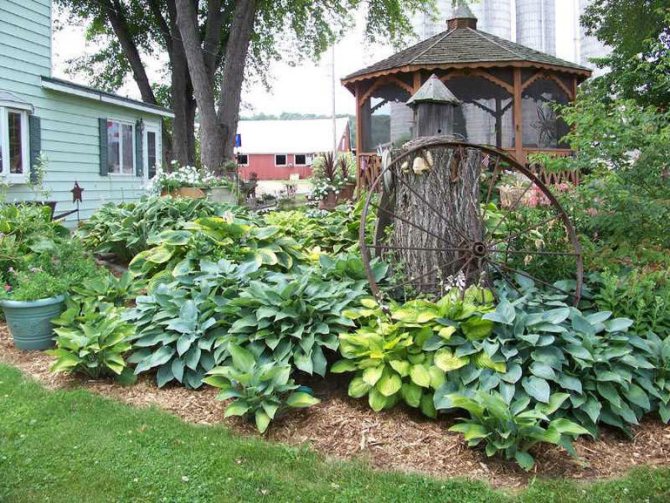

It is worth paying attention to the shape of the leaves. There are many - with smooth and wavy edges, wide and narrowed, oval and pointed. The surface also has its own characteristics: smooth or with a pronounced bulge between the veins, there is even a coating that resembles wax.
But before the hosta has its own place in the garden, it is worth clarifying what the potential of the purchased plant is. Otherwise, transplants cannot be avoided.
The fact is that in the spring it is hardly possible to understand how high the bush will grow in two or three years from that division, which was brought from the store today:
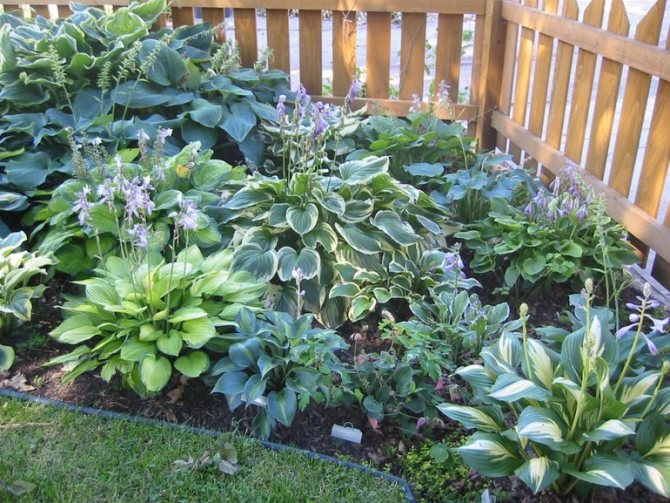

- Dwarf - up to 12 cm in height. This group includes Blue Mouse Ears, Cracker Crumbs, Teaspoon, Cherish.
- Medium, which will lift leaves up to 35 or 40 cm. For example, Fire and Ice or Wolwerine was chosen.
- High - about a meter.In Russia, Viking Ship and Tenryu have shown themselves well, its peduncle height can be more than 180 cm.
It happens that for some reason the cuttings have got no name, then it is best to plant them in areas with different illumination. If sunburn appears on the leaves, you will have to shade, and when the heat subsides, move the flower to a more suitable place with partial shade.
Landing features
When the Asian guest grows, it becomes necessary to propagate the funkia (this is the middle name of the plant). There are two ways to do the job:
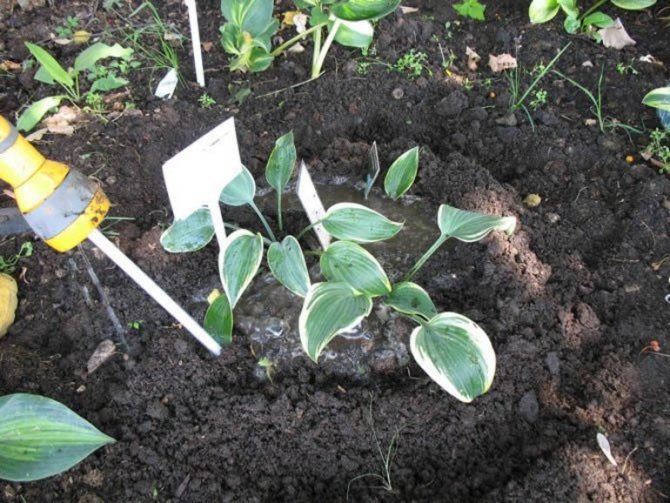

- Having dug up the whole bush and dividing it into parts, but so that in each division there is at least one growing bud. Do not allow the roots to dry out, otherwise the seedlings will not take root well.
- You can separate several seedlings, like cutting a piece of cake. With this method, the mother plant remains in place. You will need a garden knife to work.
Further, the technical side of the process is quite simple. A handful of compost is added to the prepared hole and mixed with the soil. A small cone is poured in the center so that the roots of the delenka are better distributed, one and a half liters of water are poured and the hole is covered with earth. Having compacted the soil, water it again and then repeat the procedure as the crust dries up - the young plant needs moisture. At the same time, try not to wet the leaves. 10 days after planting, it will be useful to apply a complex mineral fertilizer.
Since funkia has natural pests - snails and slugs, it does not hurt to mulch the ground around the plants with pine sawdust or bark. This will have a double benefit: the plant will be protected, and the soil will dry out less.
Planting something perennial nearby is hardly worth it. The bush will begin to approach its normal size already in the second year, and the neighbors will begin to interfere with each other.
Hosts in the neighborhood of other plants
In order for hosts to look good in combination with other crops, it is important to focus on their coloration. The color of the foliage of these plants ranges from blue-green to bluish-gray. In addition, host leaves may have contrasting spots and stripes. At the same time, as you remember, the color may change slightly due to weather conditions, the place of cultivation or the age of the host.
Hosts are good for creating contrasting compositions with other plants. Many types of garden flowers will look great against the background of their variegated green leaves. For example, blooming astilbe and the hosts complement each other beautifully, framed by simple stonework.
A good tandem is obtained from hosts with garden geranium.
It is impossible not to say about the excellent company host and peonies.
The hosts are also very good friends and geyher.
Hosts also look good in mixed flower arrangements.
Conifers are good neighbors for the host.
Besides the fact that hosts are unpretentious, they are irreplaceable in landscape design. As you can see, creating an ornamental garden on the site, lush host bushes can be combined with many cultures. You just need to choose the right variety: taking into account the color of the leaves and the size of the plant.
The design of the garden largely depends on how organically you selected the neighborhood of plants with each other, taking into account the similarity of care and growing conditions.


In the case of a host, when choosing neighbors for it, there are no problems, you just need to know some rules. Many types of garden flowers, paired with the host, create contrasting compositions, looking great against the background of its bluish-gray, textured leaves.
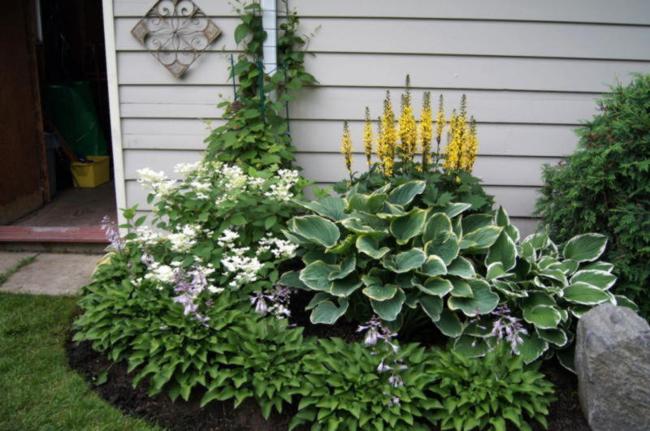

Astilba, ferns, aquilegia are traditionally considered the best partners for hosts.
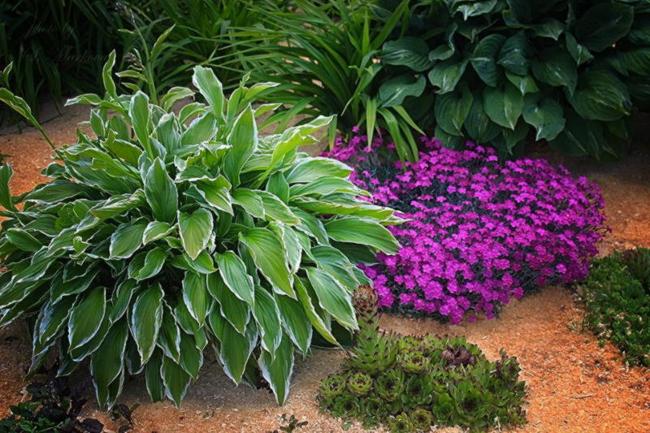

Framed by masonry, it looks spectacular on a couple of host and astilbe, this technique is used in landscape design.
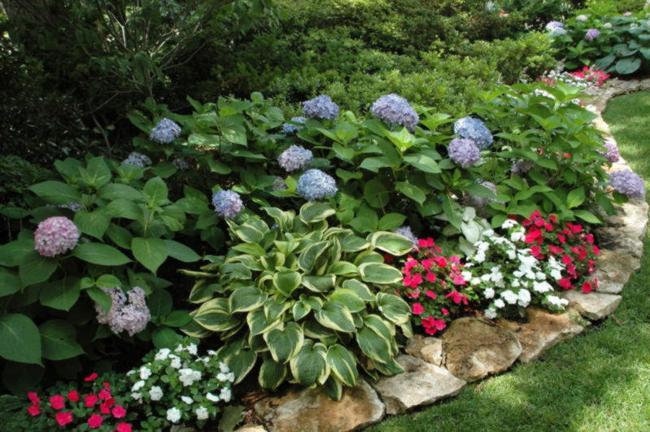

Peonies and hosta are also great for each other.


From ground cover plants, periwinkle is used as a classic addition to the host.


Marigolds, sage, lobelias, begonia, surfinias will add some charm and imposingness to the host, highlight its beauty.
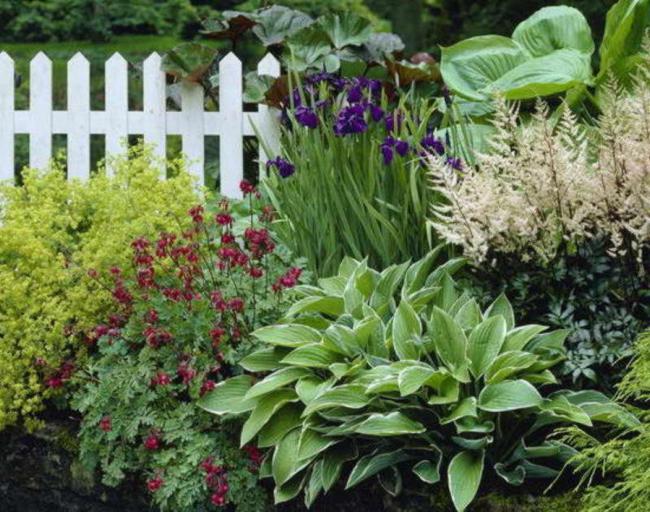

For growing hosts, it is better to select moderately humid and slightly acidic soil, in a place where there is no strong wind and direct sunlight.
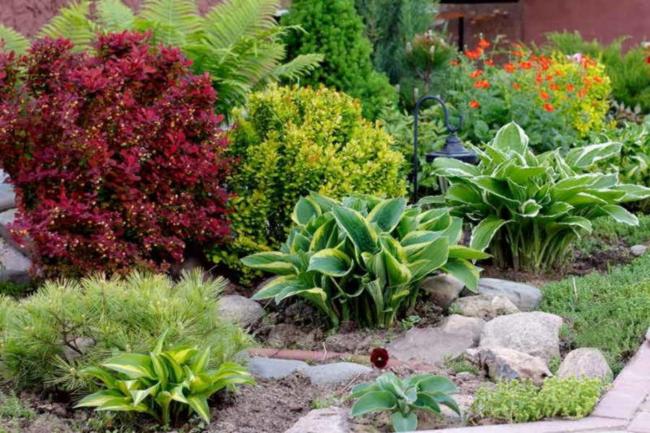

For hosts whose height is 60 cm or more, due to their self-sufficiency, partners are not required, they are good for single landings.


Low hosts up to 20 cm in size find their application in rockeries made of stones; they are usually planted in the last row of the composition, without placing them in the foreground. In the foreground, the host, 25-30 cm high, is usually placed in the curbs, planting taller plants behind it.
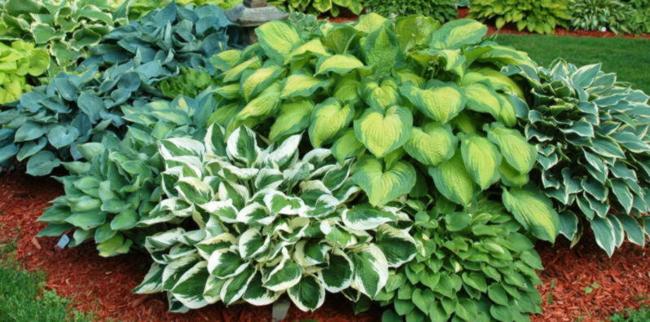

If there is a small pond on the site, then it is advised to plant a host with a height of 35-45 cm next to it, at this height it looks more advantageous against the background of water.
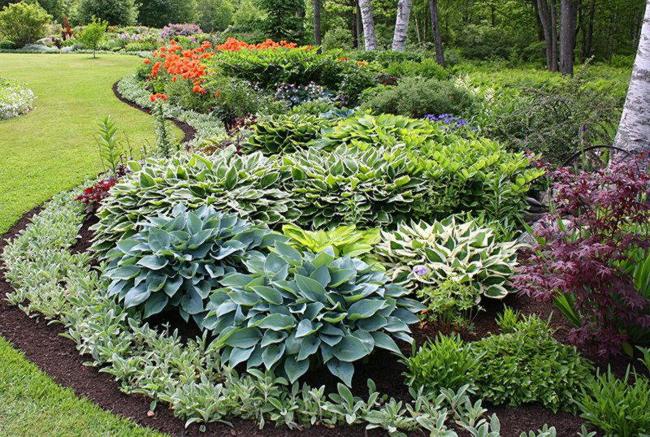

Hosta is a versatile plant to combine with different plants in the garden, try it, look for your compositions, the hosta will not disappoint you.
What is uniqueness
Hosts are famous for their non-capricious character and almost complete absence of problems with growing. In addition, plants are valued for their decorative effect, splendor, and original color of the leaves. They blend perfectly with most other flowers, shrubs and trees on the site, helping to form wonderful, picturesque compositions.
Unlike many other garden plants, the hosta prefers to be in the shade. Thus, with the help of this shrub, you can ennoble, make picturesque even those parts of the garden where all other flowers and shrubs refuse to grow.
Important: It is highly recommended to place hosts in semi-shaded and completely shady areas of the garden. This is especially true of blue varieties - in the sun their leaves turn pale, fade.


The uniqueness is also in the amazing variety of species and varieties. You can choose plants of a blue hue, with variegated leaves, with edged, huge, also any form of a shrub, and the height varies from 10 to 150 cm. Note that the selection is not completed, until now biologists are creating new hybrids.
And although many of the host and flowering plants, they are valued in landscape design, first of all, for their leaves. It is the foliage that is the main decoration and distinguishing feature of the beautiful hosts. Some gardeners generally remove flowering arrows, as soon as they have time to appear, so as not to spoil the uniform color of the plant, not to violate the style of the composition.
Note that foliage can have not only different colors, but also different surfaces: it can be matte and glossy, completely smooth and rough, wavy, similar to paper. The shape of the leaves is also different: elongated, round, sharp, heart-shaped - there is plenty to choose from.
Hosta is remarkable in that it is able to maintain the freshness and beauty of its foliage throughout the growing season. Having built up lush greenery at the very beginning of summer, it remains decorative and picturesque until frost in the fall. The shrub looks great both on ordinary flower beds and during the formation of rocky landscape elements, near a pond, as a border, as a background, an integral element of a flower arrangement.

